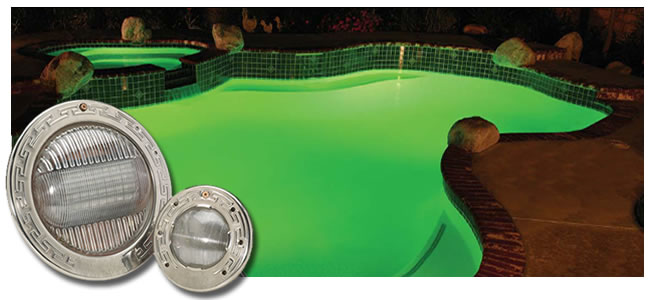Many accessories for inground pools can be changed completely at will. Inground pools lights are not such an accessory. Once they are installed you are very unlikely to ever change them so make sure you get it right the first time. In this article we will compare two types of lights: LED and fiber optic. They are the two most popular solutions on the market and have plenty of differences.
The main reasons customers typically purchase these two types of lights is for two purposes: to light up the pool and to add some color for the beauty factor. Both types are capable of accomplishing this, but in very different ways. With LEDs the actual light bulb is sealed in a typically plastic niche and placed inside the pool. The niche has to be waterproof in order not to combine water and electricity (a very dangerous combination). Fiber optics work in another way. The light bulb is actually installed in a box outside of the water and connected to a series of fiber optics cables. These cables are placed into the pool and lights travels from the bulb to the water through the cables. Knowing the fundamental ideas behind these two technologies can help us compare them and see which one is more applicable. We will use 5 categories to judge them.
How easy it is to change the light bulb
LED: Typically, in order to change a LED light bulb you do not need to lower the water level in the pool. The waterproof niche that contains the light bulb is taken out of the water where the bulb can be replaced. It is not a complicated operation and should take less than half an hour at most.
Fiber Optics: Switching a fiber optics light is even better because the niche doesn’t need to be taken out of the pool, as it’s already outside. Changing bulbs this way will only take 5 minutes.
Winner: Fiber Optics.
Costs
LED: The initial cost is fairly low, ranging from 400 to 900 dollars. Every now and then you will need to replace the bulb which likely costs around 200-400$. This only needs to be done every decade or so.
Fiber Optics: Initial cost will likely be higher starting from 900 up to around 1500 dollars. Since the system will be in a box outside of the water a fan will be used for cooling. The motor which will rotate the color wheel if you want the lights to change colors will sometimes break and need to be replaced as well as some other spare parts. Fiber optic bulbs will last only 3-7 years and will cost around 250$.
Winner: LED
LED: The initial cost is fairly low, ranging from 400 to 900 dollars. Every now and then you will need to replace the bulb which likely costs around 200-400$. This only needs to be done every decade or so.
Fiber Optics: Initial cost will likely be higher starting from 900 up to around 1500 dollars. Since the system will be in a box outside of the water a fan will be used for cooling. The motor which will rotate the color wheel if you want the lights to change colors will sometimes break and need to be replaced as well as some other spare parts. Fiber optic bulbs will last only 3-7 years and will cost around 250$.
Winner: LED
Brightness
LED: A large LED pool light will probably illuminate a residential pool very nicely. Usually, lights are installed at both ends of the pool for maximum even coverage.
Fiber Optics: Even though they aren’t necessarily bad some people find that fiber optics just aren’t that great at being bright, even with 2 lights.
And if you want to install lights at both ends of the pool you will need to purchase an entire additional kit, which can be pricey. A singe LED light can actually be brighter than 2 fiber optic lights in small pools.
Winner: LED
Size and location
LED: A light switch as well as a transformer are located outside of the pool and the actual niche with the light is installed inside the pool. The components outside the pool can be as close as 30 centimeters and as far away as 30 meters depending on the setup. Cord length may only allow for close distances.
Fiber Optics: The housing containing the bulb, cooling mechanism and other machinery has to be within 25-30 centimeters from the pool which can put a damper on some designs.
Winner: LED
Safety Hazards
LED: LED lights tend to be quite safe even though they are located inside the water. Incidents very rarely happen and even when they do, LED lights tend to be low voltage thanks to the transformer (likely around 12 volts).
Fiber Optics: No electricity is inside the water. Only the cables are in contact with the pool. Everything else is inside the dry box.
Winner: Fiber Optics by a very slight margin.
Conclusion: So which technology is better? Many experts prefer fiber optics but many others prefer LED. In general however, LED lights are considered preferable. Not to downplay the benefits of fiber optics but LEDs tend to be both significantly brighter as well as cheaper. There is also no large illuminator box to deal with and there is more freedom as to where the other components are located.
Overall Winner: LEDs
